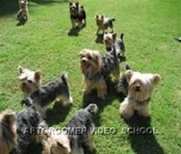 |
Schnauzer Giant
Other Names: Riesenschnauzer Country of origin: Germany Dog Group Kennel Club: Working General appearance: Giant Schnauzers are large dogs with a robust and compact appearance. Giant Schnauzers are double coated breeds. They have soft undercoats and harsh, wiry outer coats. Also have harsh hair on their legs. The hair is longer over the eyes and on the muzzle to form bushy eyebrows and a distinctive beard. The hair on the legs is longer than the body coat. The Giant Schnauzer is a large sized dog that appears almost square. The breed is sturdy and muscular with an alert outlook. The Giant has a rectangular head and the body length equals the height at the withers.
Colours: Black or salt and pepper shades. Size: Dog 65 - 70cms Bitch 60 - 65cms Weight: Min Max Temperament: Giant Schnauzers are loyal and intelligent with great adaptability. They need a fair amount of exercise and benefit from training due to their power and size. Giant Schnauzers are weather resistant and, despite their sturdy appearance, are capable of speed. This breed is very loving, protective, and responsible. They thrive on human companionship and do not do well if left alone for extended periods of time. They are not recommended for the novice dog owner, two-career family, or a sedentary owner. This bold breed is intense and complex and requires an owner who completely understands them. They are highly intelligent, imposing, and extremely protective of their family and territory. They make excellent guard dogs. Movement: Free with good reach. Care and training: The Giant Schnauzer requires weekly brushing and combing to keep the under coat free of mats and tangles. They need to be professionally clipped all-over four times per year. The hair around the eyes and ears must be kept trimmed and their whiskers cleaned after meals. Bathing or dry shampooing should be done when necessary. Hand stripping is a must for the show ring but clipping is straightforward and easy for the smart family pet. The Giant Schnauzer is an intelligent dog that is easily trained, although it does need consistent training, as they can be quite stubborn. As puppies they do require lots of socialisation and training. They are a dominant breed and require an experienced and dominant owner who will let them know who the boss is. They are easily housebroken and trained. The Giant Schnauzer responds to respect, consistency, firmness, fairness, positive reinforcement, and reward. They excel in agility, obedience, schutzhound, and are often used as therapy and police dogs. Overall Exercise: 2 hours per day. Feeding requirements: The Schnauzer is a fairly undemanding dog feeding wise. Exercise: Med Grooming: Med Noise: Low Personal Protection: Medium Suitability As Guard Dog: High Level of Aggression: Low Compatibility With Other Animals: High Suitablity for Children: High Often docked? Yes Average litter size: 5 - 8 Life expectancy (yrs): 9 - 12 Health issues: Giant Schnauzers may also suffer from orthopedic problems, albinism, epilepsy, hypothyroidism and renal problems. History: Originating from an area near Munich, Germany, Giant Schnauzers originally weren't Schnauzers at all! It is believed that Giant Schnauzers originated from crosses of smooth-coated drover dogs, rough-coated shepherds, black Great Danes and the Bouvier des Flandres. They were first known as the Riesenschnauzer. Later they were known as the Münchener Dog because of their origin. Giant Schnauzers have been in use for driving livestock since the 15th century. Used to herd and drive cattle, Giant Schnauzers were useful dogs among farmers. But due to lack of cattle drives and the large stomach this Schnauzer had, the species soon worked in cities as mascots for beer halls and butcher shops in the 19th century. Eventually breeders saw a similarity among the Giant and regular Schnauzers, and this is when they decided to interbreed them, making the Giant Schnauzer what he is today. At first they were called Munich Schnauzers until the term "giant" tagged along. In 1909 the breed was first shown in Munich, and the breed was accepted by the public.
|
|
|
|
